Economics Assignment: Analysis of Australian Dollar Exchange Rates
VerifiedAdded on 2021/04/21
|13
|2933
|29
Homework Assignment
AI Summary
This economics assignment provides a comprehensive analysis of the Australian Dollar (AUD) exchange rate. It begins by explaining the concept of foreign exchange and the determination of exchange rates using the demand and supply framework, focusing on the AUD/USD pair. The assignment then explores various factors affecting the AUD's exchange rate, including interest rates, inflation, and government policies. It differentiates between nominal exchange rates and the Trade Weighted Index (TWI), illustrating fluctuations in both. The assignment further examines a report predicting a potential fall in the AUD value, attributing it to factors like a weak USD, commodity prices, and interest rate differentials. The impact of an expected AUD depreciation on imports and exports is discussed, followed by an analysis of monetary policy measures to appreciate the AUD, such as interest rate adjustments and currency interventions. The assignment utilizes figures and diagrams to visually represent the concepts and dynamics discussed.
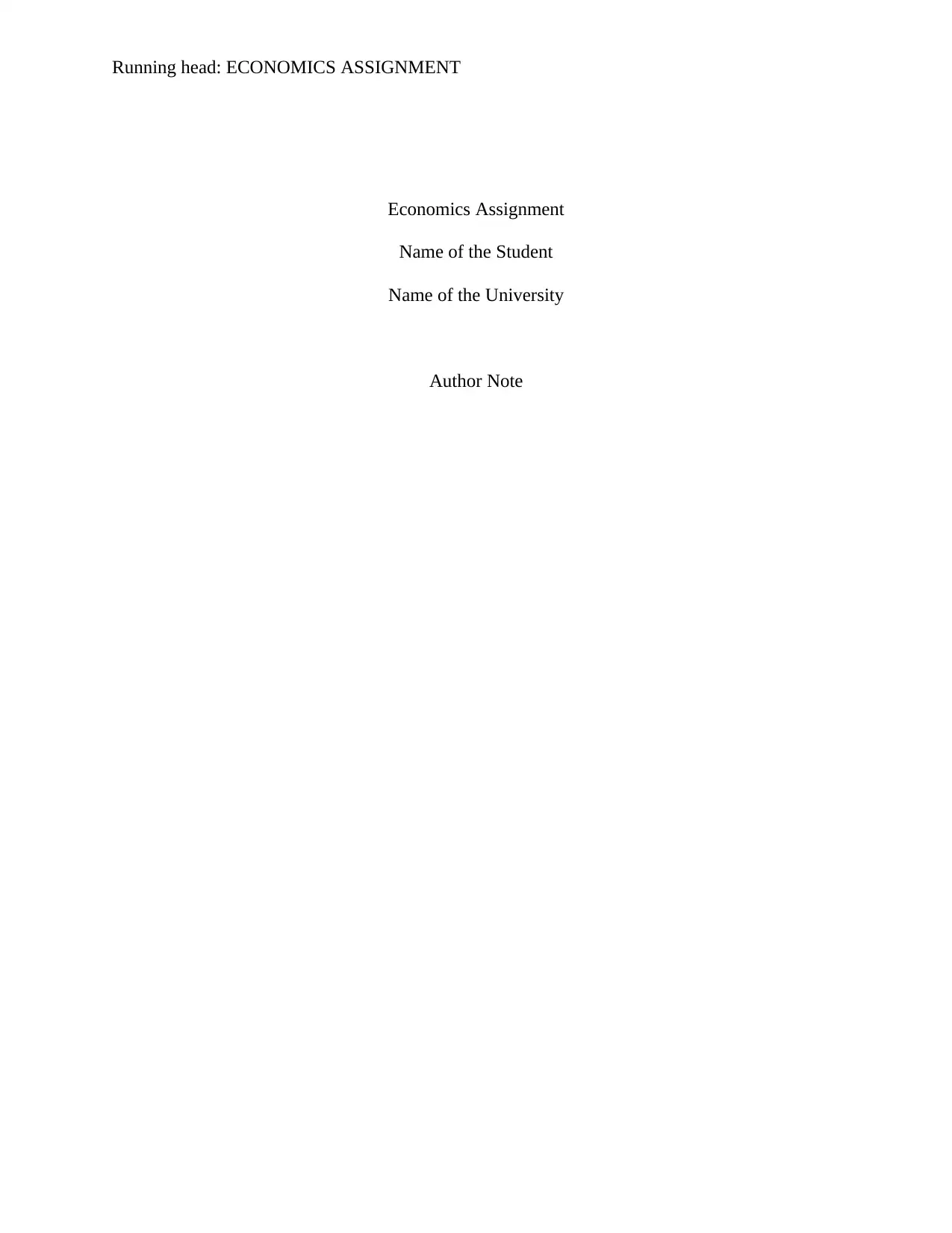
Running head: ECONOMICS ASSIGNMENT
Economics Assignment
Name of the Student
Name of the University
Author Note
Economics Assignment
Name of the Student
Name of the University
Author Note
Paraphrase This Document
Need a fresh take? Get an instant paraphrase of this document with our AI Paraphraser

1ECONOMICS ASSIGNMENT
Table of Contents
Answer a:.........................................................................................................................................2
Answer b:.........................................................................................................................................5
Answer c:.........................................................................................................................................7
Answer d:.........................................................................................................................................8
Answer e:.........................................................................................................................................9
Table of Contents
Answer a:.........................................................................................................................................2
Answer b:.........................................................................................................................................5
Answer c:.........................................................................................................................................7
Answer d:.........................................................................................................................................8
Answer e:.........................................................................................................................................9
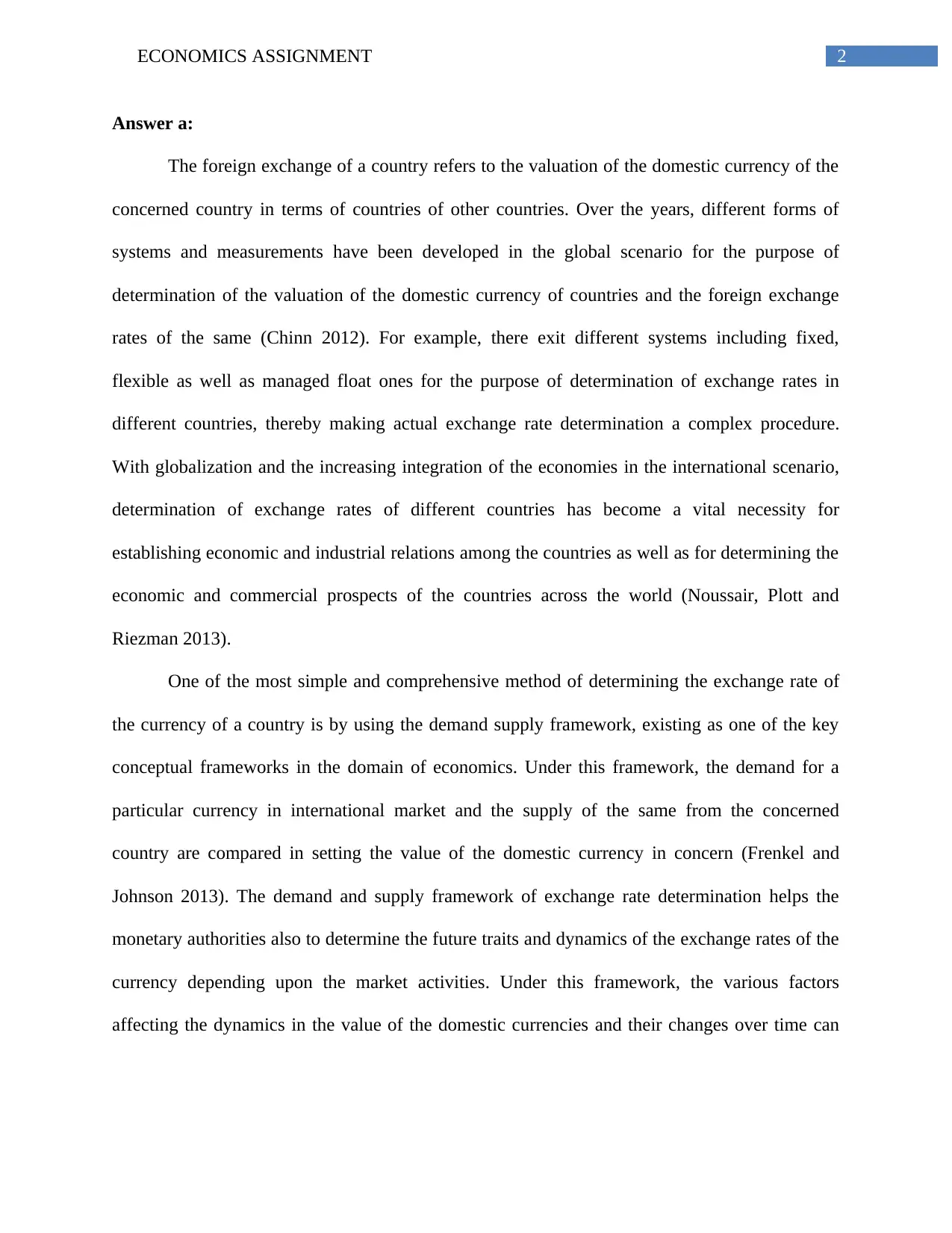
2ECONOMICS ASSIGNMENT
Answer a:
The foreign exchange of a country refers to the valuation of the domestic currency of the
concerned country in terms of countries of other countries. Over the years, different forms of
systems and measurements have been developed in the global scenario for the purpose of
determination of the valuation of the domestic currency of countries and the foreign exchange
rates of the same (Chinn 2012). For example, there exit different systems including fixed,
flexible as well as managed float ones for the purpose of determination of exchange rates in
different countries, thereby making actual exchange rate determination a complex procedure.
With globalization and the increasing integration of the economies in the international scenario,
determination of exchange rates of different countries has become a vital necessity for
establishing economic and industrial relations among the countries as well as for determining the
economic and commercial prospects of the countries across the world (Noussair, Plott and
Riezman 2013).
One of the most simple and comprehensive method of determining the exchange rate of
the currency of a country is by using the demand supply framework, existing as one of the key
conceptual frameworks in the domain of economics. Under this framework, the demand for a
particular currency in international market and the supply of the same from the concerned
country are compared in setting the value of the domestic currency in concern (Frenkel and
Johnson 2013). The demand and supply framework of exchange rate determination helps the
monetary authorities also to determine the future traits and dynamics of the exchange rates of the
currency depending upon the market activities. Under this framework, the various factors
affecting the dynamics in the value of the domestic currencies and their changes over time can
Answer a:
The foreign exchange of a country refers to the valuation of the domestic currency of the
concerned country in terms of countries of other countries. Over the years, different forms of
systems and measurements have been developed in the global scenario for the purpose of
determination of the valuation of the domestic currency of countries and the foreign exchange
rates of the same (Chinn 2012). For example, there exit different systems including fixed,
flexible as well as managed float ones for the purpose of determination of exchange rates in
different countries, thereby making actual exchange rate determination a complex procedure.
With globalization and the increasing integration of the economies in the international scenario,
determination of exchange rates of different countries has become a vital necessity for
establishing economic and industrial relations among the countries as well as for determining the
economic and commercial prospects of the countries across the world (Noussair, Plott and
Riezman 2013).
One of the most simple and comprehensive method of determining the exchange rate of
the currency of a country is by using the demand supply framework, existing as one of the key
conceptual frameworks in the domain of economics. Under this framework, the demand for a
particular currency in international market and the supply of the same from the concerned
country are compared in setting the value of the domestic currency in concern (Frenkel and
Johnson 2013). The demand and supply framework of exchange rate determination helps the
monetary authorities also to determine the future traits and dynamics of the exchange rates of the
currency depending upon the market activities. Under this framework, the various factors
affecting the dynamics in the value of the domestic currencies and their changes over time can
⊘ This is a preview!⊘
Do you want full access?
Subscribe today to unlock all pages.

Trusted by 1+ million students worldwide
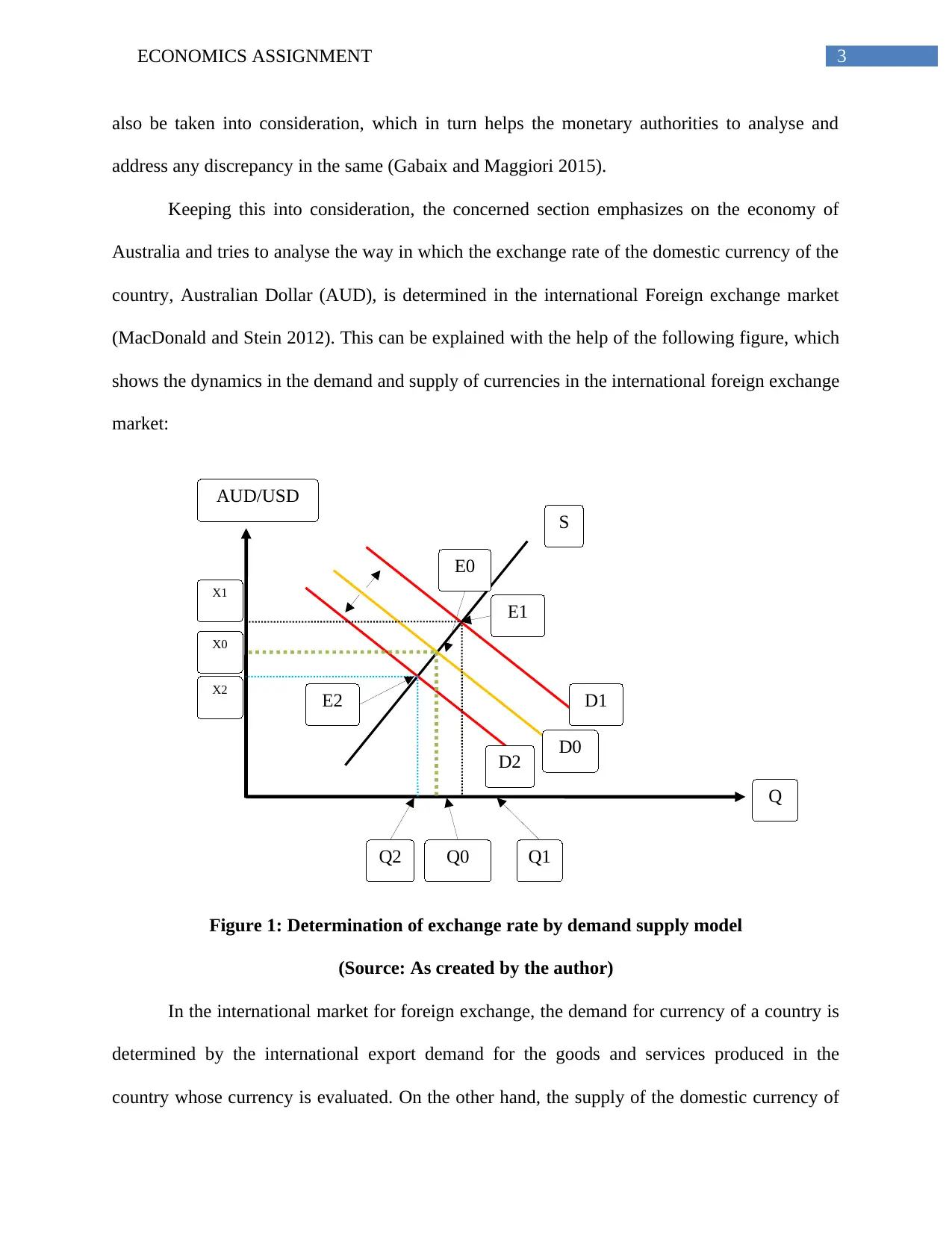
AUD/USD
S
D1
D0
D2
Q
Q2 Q0 Q1
E1
E2
E0
X0
X1
X2
3ECONOMICS ASSIGNMENT
also be taken into consideration, which in turn helps the monetary authorities to analyse and
address any discrepancy in the same (Gabaix and Maggiori 2015).
Keeping this into consideration, the concerned section emphasizes on the economy of
Australia and tries to analyse the way in which the exchange rate of the domestic currency of the
country, Australian Dollar (AUD), is determined in the international Foreign exchange market
(MacDonald and Stein 2012). This can be explained with the help of the following figure, which
shows the dynamics in the demand and supply of currencies in the international foreign exchange
market:
Figure 1: Determination of exchange rate by demand supply model
(Source: As created by the author)
In the international market for foreign exchange, the demand for currency of a country is
determined by the international export demand for the goods and services produced in the
country whose currency is evaluated. On the other hand, the supply of the domestic currency of
S
D1
D0
D2
Q
Q2 Q0 Q1
E1
E2
E0
X0
X1
X2
3ECONOMICS ASSIGNMENT
also be taken into consideration, which in turn helps the monetary authorities to analyse and
address any discrepancy in the same (Gabaix and Maggiori 2015).
Keeping this into consideration, the concerned section emphasizes on the economy of
Australia and tries to analyse the way in which the exchange rate of the domestic currency of the
country, Australian Dollar (AUD), is determined in the international Foreign exchange market
(MacDonald and Stein 2012). This can be explained with the help of the following figure, which
shows the dynamics in the demand and supply of currencies in the international foreign exchange
market:
Figure 1: Determination of exchange rate by demand supply model
(Source: As created by the author)
In the international market for foreign exchange, the demand for currency of a country is
determined by the international export demand for the goods and services produced in the
country whose currency is evaluated. On the other hand, the supply of the domestic currency of
Paraphrase This Document
Need a fresh take? Get an instant paraphrase of this document with our AI Paraphraser
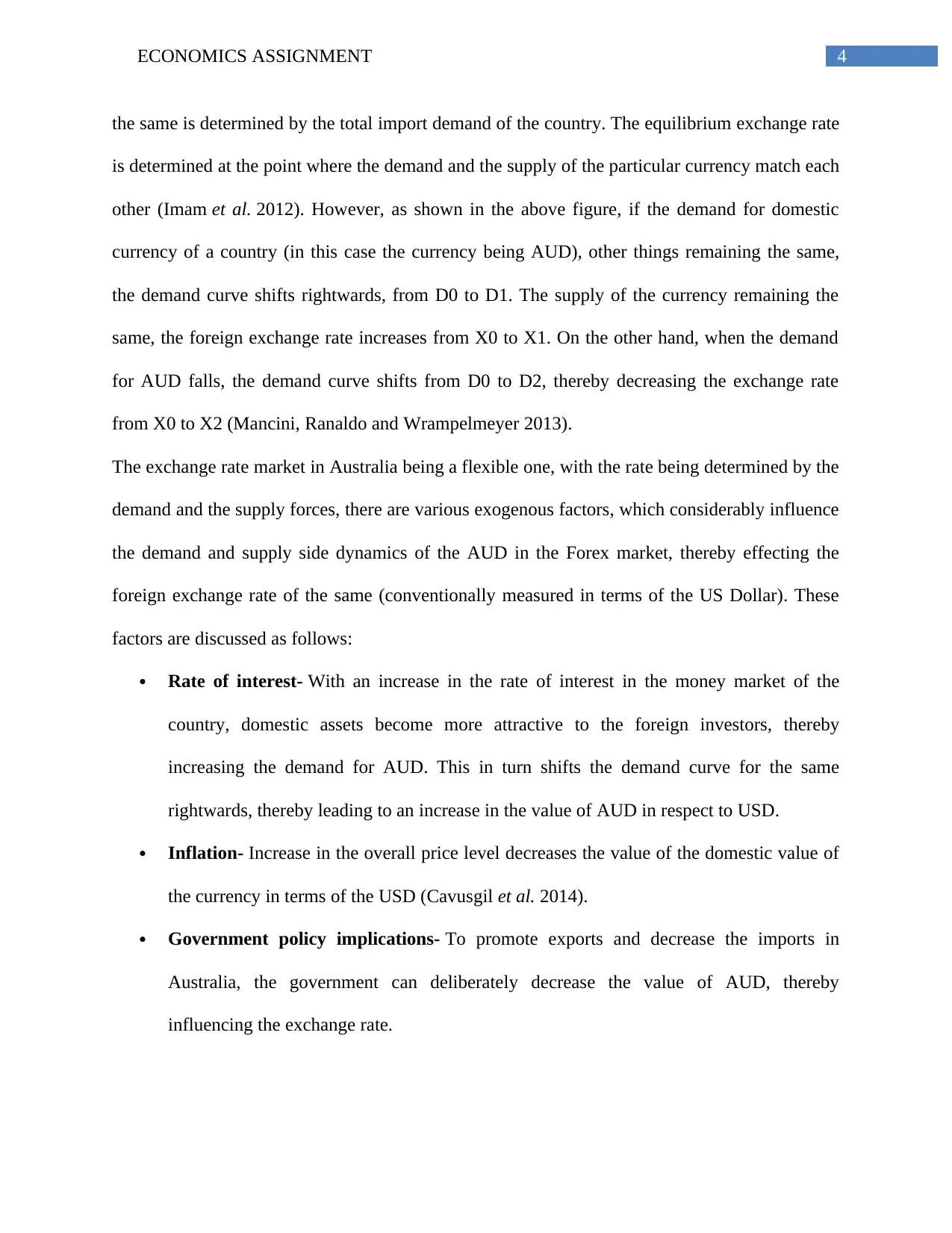
4ECONOMICS ASSIGNMENT
the same is determined by the total import demand of the country. The equilibrium exchange rate
is determined at the point where the demand and the supply of the particular currency match each
other (Imam et al. 2012). However, as shown in the above figure, if the demand for domestic
currency of a country (in this case the currency being AUD), other things remaining the same,
the demand curve shifts rightwards, from D0 to D1. The supply of the currency remaining the
same, the foreign exchange rate increases from X0 to X1. On the other hand, when the demand
for AUD falls, the demand curve shifts from D0 to D2, thereby decreasing the exchange rate
from X0 to X2 (Mancini, Ranaldo and Wrampelmeyer 2013).
The exchange rate market in Australia being a flexible one, with the rate being determined by the
demand and the supply forces, there are various exogenous factors, which considerably influence
the demand and supply side dynamics of the AUD in the Forex market, thereby effecting the
foreign exchange rate of the same (conventionally measured in terms of the US Dollar). These
factors are discussed as follows:
Rate of interest- With an increase in the rate of interest in the money market of the
country, domestic assets become more attractive to the foreign investors, thereby
increasing the demand for AUD. This in turn shifts the demand curve for the same
rightwards, thereby leading to an increase in the value of AUD in respect to USD.
Inflation- Increase in the overall price level decreases the value of the domestic value of
the currency in terms of the USD (Cavusgil et al. 2014).
Government policy implications- To promote exports and decrease the imports in
Australia, the government can deliberately decrease the value of AUD, thereby
influencing the exchange rate.
the same is determined by the total import demand of the country. The equilibrium exchange rate
is determined at the point where the demand and the supply of the particular currency match each
other (Imam et al. 2012). However, as shown in the above figure, if the demand for domestic
currency of a country (in this case the currency being AUD), other things remaining the same,
the demand curve shifts rightwards, from D0 to D1. The supply of the currency remaining the
same, the foreign exchange rate increases from X0 to X1. On the other hand, when the demand
for AUD falls, the demand curve shifts from D0 to D2, thereby decreasing the exchange rate
from X0 to X2 (Mancini, Ranaldo and Wrampelmeyer 2013).
The exchange rate market in Australia being a flexible one, with the rate being determined by the
demand and the supply forces, there are various exogenous factors, which considerably influence
the demand and supply side dynamics of the AUD in the Forex market, thereby effecting the
foreign exchange rate of the same (conventionally measured in terms of the US Dollar). These
factors are discussed as follows:
Rate of interest- With an increase in the rate of interest in the money market of the
country, domestic assets become more attractive to the foreign investors, thereby
increasing the demand for AUD. This in turn shifts the demand curve for the same
rightwards, thereby leading to an increase in the value of AUD in respect to USD.
Inflation- Increase in the overall price level decreases the value of the domestic value of
the currency in terms of the USD (Cavusgil et al. 2014).
Government policy implications- To promote exports and decrease the imports in
Australia, the government can deliberately decrease the value of AUD, thereby
influencing the exchange rate.

5ECONOMICS ASSIGNMENT
There may also be other country specific factors apart from the above-mentioned ones which
can influence the exchange rate of a currency of a country.
Answer b:
The nominal exchange rate of the currency of a country is the number of units of the
domestic currency which the country needs to let go to attain one additional unit of the currency
of any other country. There occurs depreciation in the nominal exchange rate of the currency of a
country with the increase in the purchasing power and vice versa (Diebold 2012). The Trade
Weight Index, on the other hand, of a country shows the material rate of exchange, which
incorporates the weighted average of the domestic currency of the concerned country vis-à-vis
that of any foreign currency, which is measured in terms of trade share of the country with the
trading partners. The TWI also depends upon the business magnitude of the country with its
different trading partners (Burstein and Gopinath 2014).
Keeping these measures into consideration, in the Australian economy, considerable fluctuations
can be noticed in both nominal exchange rate as well as in the TWI, in the previous three years,
which can be shown as follows:
1-Jan-2015
1-Apr-2015
1-Jul-2015
1-Oct-2015
1-Jan-2016
1-Apr-2016
1-Jul-2016
1-Oct-2016
1-Jan-2017
1-Apr-2017
1-Jul-2017
1-Oct-2017
0.6400
0.6800
0.7200
0.7600
0.8000
Nominal rate of exchange
Nominal ex. Rate
Axis Title
Figure 2: Nominal Rate of Exchange in Australia
(Source: Reserve Bank of Australia, 2018)
There may also be other country specific factors apart from the above-mentioned ones which
can influence the exchange rate of a currency of a country.
Answer b:
The nominal exchange rate of the currency of a country is the number of units of the
domestic currency which the country needs to let go to attain one additional unit of the currency
of any other country. There occurs depreciation in the nominal exchange rate of the currency of a
country with the increase in the purchasing power and vice versa (Diebold 2012). The Trade
Weight Index, on the other hand, of a country shows the material rate of exchange, which
incorporates the weighted average of the domestic currency of the concerned country vis-à-vis
that of any foreign currency, which is measured in terms of trade share of the country with the
trading partners. The TWI also depends upon the business magnitude of the country with its
different trading partners (Burstein and Gopinath 2014).
Keeping these measures into consideration, in the Australian economy, considerable fluctuations
can be noticed in both nominal exchange rate as well as in the TWI, in the previous three years,
which can be shown as follows:
1-Jan-2015
1-Apr-2015
1-Jul-2015
1-Oct-2015
1-Jan-2016
1-Apr-2016
1-Jul-2016
1-Oct-2016
1-Jan-2017
1-Apr-2017
1-Jul-2017
1-Oct-2017
0.6400
0.6800
0.7200
0.7600
0.8000
Nominal rate of exchange
Nominal ex. Rate
Axis Title
Figure 2: Nominal Rate of Exchange in Australia
(Source: Reserve Bank of Australia, 2018)
⊘ This is a preview!⊘
Do you want full access?
Subscribe today to unlock all pages.

Trusted by 1+ million students worldwide
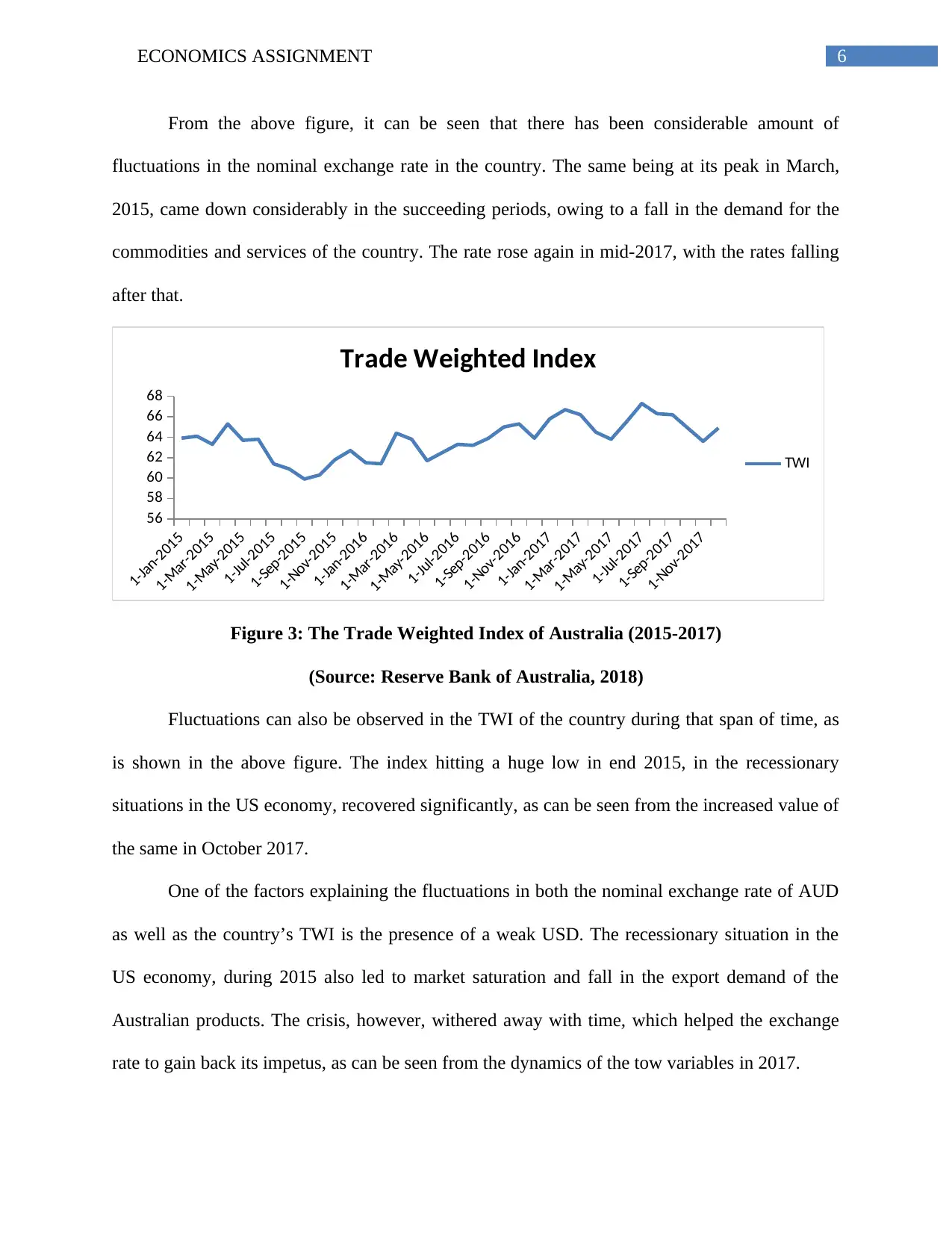
6ECONOMICS ASSIGNMENT
From the above figure, it can be seen that there has been considerable amount of
fluctuations in the nominal exchange rate in the country. The same being at its peak in March,
2015, came down considerably in the succeeding periods, owing to a fall in the demand for the
commodities and services of the country. The rate rose again in mid-2017, with the rates falling
after that.
1-Jan-2015
1-Mar-2015
1-May-2015
1-Jul-2015
1-Sep-2015
1-Nov-2015
1-Jan-2016
1-Mar-2016
1-May-2016
1-Jul-2016
1-Sep-2016
1-Nov-2016
1-Jan-2017
1-Mar-2017
1-May-2017
1-Jul-2017
1-Sep-2017
1-Nov-2017
56
58
60
62
64
66
68
Trade Weighted Index
TWI
Figure 3: The Trade Weighted Index of Australia (2015-2017)
(Source: Reserve Bank of Australia, 2018)
Fluctuations can also be observed in the TWI of the country during that span of time, as
is shown in the above figure. The index hitting a huge low in end 2015, in the recessionary
situations in the US economy, recovered significantly, as can be seen from the increased value of
the same in October 2017.
One of the factors explaining the fluctuations in both the nominal exchange rate of AUD
as well as the country’s TWI is the presence of a weak USD. The recessionary situation in the
US economy, during 2015 also led to market saturation and fall in the export demand of the
Australian products. The crisis, however, withered away with time, which helped the exchange
rate to gain back its impetus, as can be seen from the dynamics of the tow variables in 2017.
From the above figure, it can be seen that there has been considerable amount of
fluctuations in the nominal exchange rate in the country. The same being at its peak in March,
2015, came down considerably in the succeeding periods, owing to a fall in the demand for the
commodities and services of the country. The rate rose again in mid-2017, with the rates falling
after that.
1-Jan-2015
1-Mar-2015
1-May-2015
1-Jul-2015
1-Sep-2015
1-Nov-2015
1-Jan-2016
1-Mar-2016
1-May-2016
1-Jul-2016
1-Sep-2016
1-Nov-2016
1-Jan-2017
1-Mar-2017
1-May-2017
1-Jul-2017
1-Sep-2017
1-Nov-2017
56
58
60
62
64
66
68
Trade Weighted Index
TWI
Figure 3: The Trade Weighted Index of Australia (2015-2017)
(Source: Reserve Bank of Australia, 2018)
Fluctuations can also be observed in the TWI of the country during that span of time, as
is shown in the above figure. The index hitting a huge low in end 2015, in the recessionary
situations in the US economy, recovered significantly, as can be seen from the increased value of
the same in October 2017.
One of the factors explaining the fluctuations in both the nominal exchange rate of AUD
as well as the country’s TWI is the presence of a weak USD. The recessionary situation in the
US economy, during 2015 also led to market saturation and fall in the export demand of the
Australian products. The crisis, however, withered away with time, which helped the exchange
rate to gain back its impetus, as can be seen from the dynamics of the tow variables in 2017.
Paraphrase This Document
Need a fresh take? Get an instant paraphrase of this document with our AI Paraphraser

7ECONOMICS ASSIGNMENT
Answer c:
This section of the assignment takes reference of the report and shows that there are
several factors working behind the fluctuation of the domestic currency of Australia in
comparison to USD. Of these the key reason, is the recent slump in the US dollars and a
simultaneous increase in the price of commodities like iron ore and other, which has resulted in a
hike in the exports from Australia to the USA, thereby leading to an increase in the value of
AUD with respect to currency of the USA (Ismail 2018).
However, this rise in the AUD value, as per the assertions of the concerned report is not
expected to be long term sustainable. The report attributes this assertion to the stagnation of the
wage rates and price level dynamics in the economy of Australia. This, clubbed with the fall in
the price of iron ore in the international scenario, the fluctuations in the economic growth of
China as well as the rise in the interest rate of the USA, are expected to contribute negatively to
the sustainability of the high value of AUD (Manalo, Perera and Rees 2015). The value of the
same is expected to fall below that of 70c, with the fall in the exports and the rise in the rate of
interest in the USA, which can be shown with the help of the demand supply framework as
follows:
Answer c:
This section of the assignment takes reference of the report and shows that there are
several factors working behind the fluctuation of the domestic currency of Australia in
comparison to USD. Of these the key reason, is the recent slump in the US dollars and a
simultaneous increase in the price of commodities like iron ore and other, which has resulted in a
hike in the exports from Australia to the USA, thereby leading to an increase in the value of
AUD with respect to currency of the USA (Ismail 2018).
However, this rise in the AUD value, as per the assertions of the concerned report is not
expected to be long term sustainable. The report attributes this assertion to the stagnation of the
wage rates and price level dynamics in the economy of Australia. This, clubbed with the fall in
the price of iron ore in the international scenario, the fluctuations in the economic growth of
China as well as the rise in the interest rate of the USA, are expected to contribute negatively to
the sustainability of the high value of AUD (Manalo, Perera and Rees 2015). The value of the
same is expected to fall below that of 70c, with the fall in the exports and the rise in the rate of
interest in the USA, which can be shown with the help of the demand supply framework as
follows:

Exchange rate
S
D1
D0
D2
Q
Q2 Q0 Q1
E1
E2
E0
X0
X1
X2
8ECONOMICS ASSIGNMENT
Figure 4: Dynamics in the exchange rate (AUD/USD) in the demand and supply framework
(Source: As created by the author)
As is evident from the above figure, with the slump in USD and the rise in the Australian
exports, the demand for AUD is expected to increase, thereby shifting the demand curve from
D0 to D1. This in turn shifts the equilibrium from E0 to E1, thereby hiking the exchange rate to
X1. However, with the factors like fall in the iron ore price as well as the increase in the interest
rate gap between the USA and Australia, the demand for AUD is expected to fall. If the
magnitude of fall surpasses that of the initial rise, then the equilibrium is expected to shift to E2,
thereby leading to a fall in the exchange rate (X2) (Rossi 2013).
Answer d:
An expected fall in the value of the AUD, in one year, from 80C per AUD to 70C per
AUD is expected to make the imports in Australia from that of the USA more expensive.
Keeping this into consideration, the Australian firm, which imports electrical machineries from
S
D1
D0
D2
Q
Q2 Q0 Q1
E1
E2
E0
X0
X1
X2
8ECONOMICS ASSIGNMENT
Figure 4: Dynamics in the exchange rate (AUD/USD) in the demand and supply framework
(Source: As created by the author)
As is evident from the above figure, with the slump in USD and the rise in the Australian
exports, the demand for AUD is expected to increase, thereby shifting the demand curve from
D0 to D1. This in turn shifts the equilibrium from E0 to E1, thereby hiking the exchange rate to
X1. However, with the factors like fall in the iron ore price as well as the increase in the interest
rate gap between the USA and Australia, the demand for AUD is expected to fall. If the
magnitude of fall surpasses that of the initial rise, then the equilibrium is expected to shift to E2,
thereby leading to a fall in the exchange rate (X2) (Rossi 2013).
Answer d:
An expected fall in the value of the AUD, in one year, from 80C per AUD to 70C per
AUD is expected to make the imports in Australia from that of the USA more expensive.
Keeping this into consideration, the Australian firm, which imports electrical machineries from
⊘ This is a preview!⊘
Do you want full access?
Subscribe today to unlock all pages.

Trusted by 1+ million students worldwide
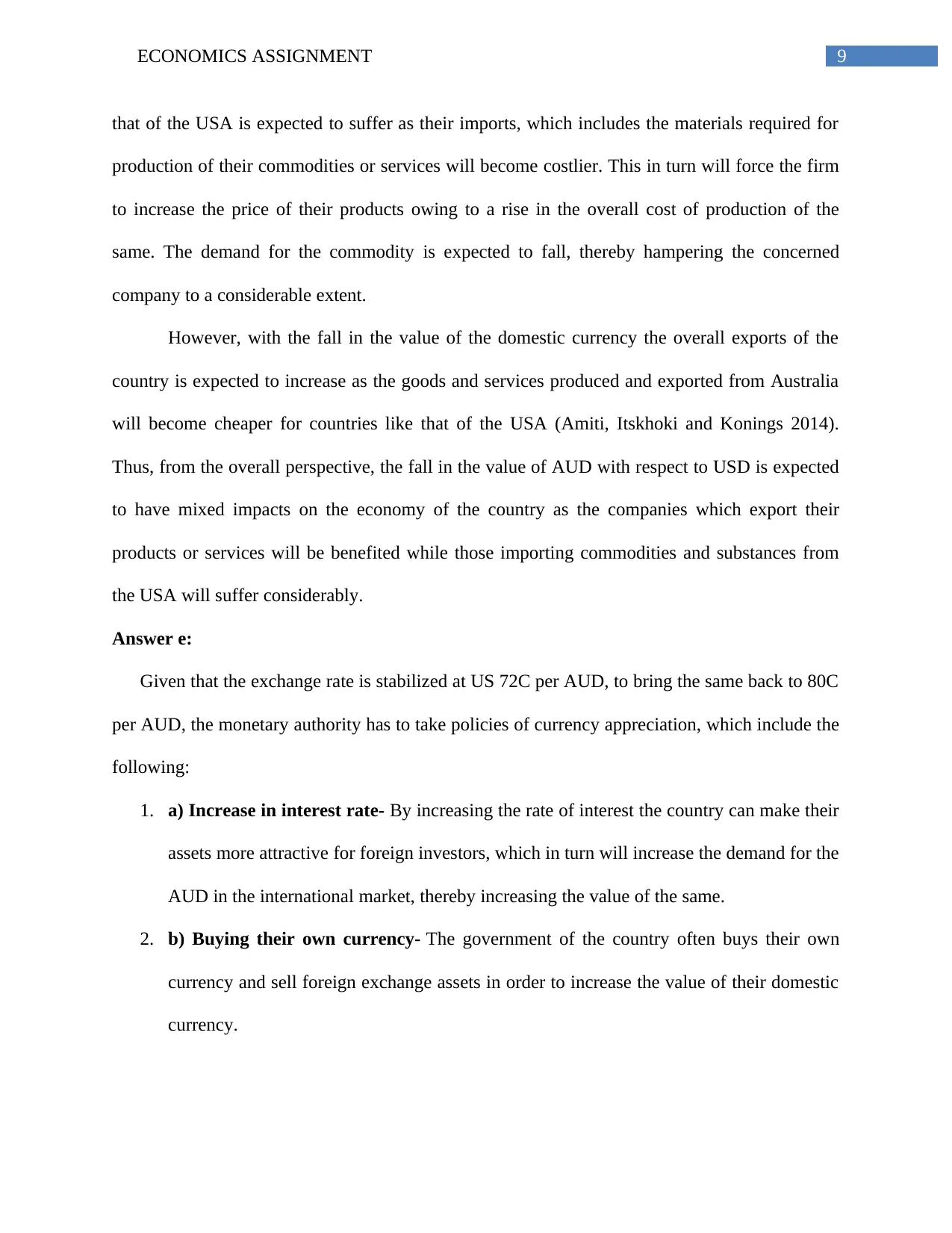
9ECONOMICS ASSIGNMENT
that of the USA is expected to suffer as their imports, which includes the materials required for
production of their commodities or services will become costlier. This in turn will force the firm
to increase the price of their products owing to a rise in the overall cost of production of the
same. The demand for the commodity is expected to fall, thereby hampering the concerned
company to a considerable extent.
However, with the fall in the value of the domestic currency the overall exports of the
country is expected to increase as the goods and services produced and exported from Australia
will become cheaper for countries like that of the USA (Amiti, Itskhoki and Konings 2014).
Thus, from the overall perspective, the fall in the value of AUD with respect to USD is expected
to have mixed impacts on the economy of the country as the companies which export their
products or services will be benefited while those importing commodities and substances from
the USA will suffer considerably.
Answer e:
Given that the exchange rate is stabilized at US 72C per AUD, to bring the same back to 80C
per AUD, the monetary authority has to take policies of currency appreciation, which include the
following:
1. a) Increase in interest rate- By increasing the rate of interest the country can make their
assets more attractive for foreign investors, which in turn will increase the demand for the
AUD in the international market, thereby increasing the value of the same.
2. b) Buying their own currency- The government of the country often buys their own
currency and sell foreign exchange assets in order to increase the value of their domestic
currency.
that of the USA is expected to suffer as their imports, which includes the materials required for
production of their commodities or services will become costlier. This in turn will force the firm
to increase the price of their products owing to a rise in the overall cost of production of the
same. The demand for the commodity is expected to fall, thereby hampering the concerned
company to a considerable extent.
However, with the fall in the value of the domestic currency the overall exports of the
country is expected to increase as the goods and services produced and exported from Australia
will become cheaper for countries like that of the USA (Amiti, Itskhoki and Konings 2014).
Thus, from the overall perspective, the fall in the value of AUD with respect to USD is expected
to have mixed impacts on the economy of the country as the companies which export their
products or services will be benefited while those importing commodities and substances from
the USA will suffer considerably.
Answer e:
Given that the exchange rate is stabilized at US 72C per AUD, to bring the same back to 80C
per AUD, the monetary authority has to take policies of currency appreciation, which include the
following:
1. a) Increase in interest rate- By increasing the rate of interest the country can make their
assets more attractive for foreign investors, which in turn will increase the demand for the
AUD in the international market, thereby increasing the value of the same.
2. b) Buying their own currency- The government of the country often buys their own
currency and sell foreign exchange assets in order to increase the value of their domestic
currency.
Paraphrase This Document
Need a fresh take? Get an instant paraphrase of this document with our AI Paraphraser
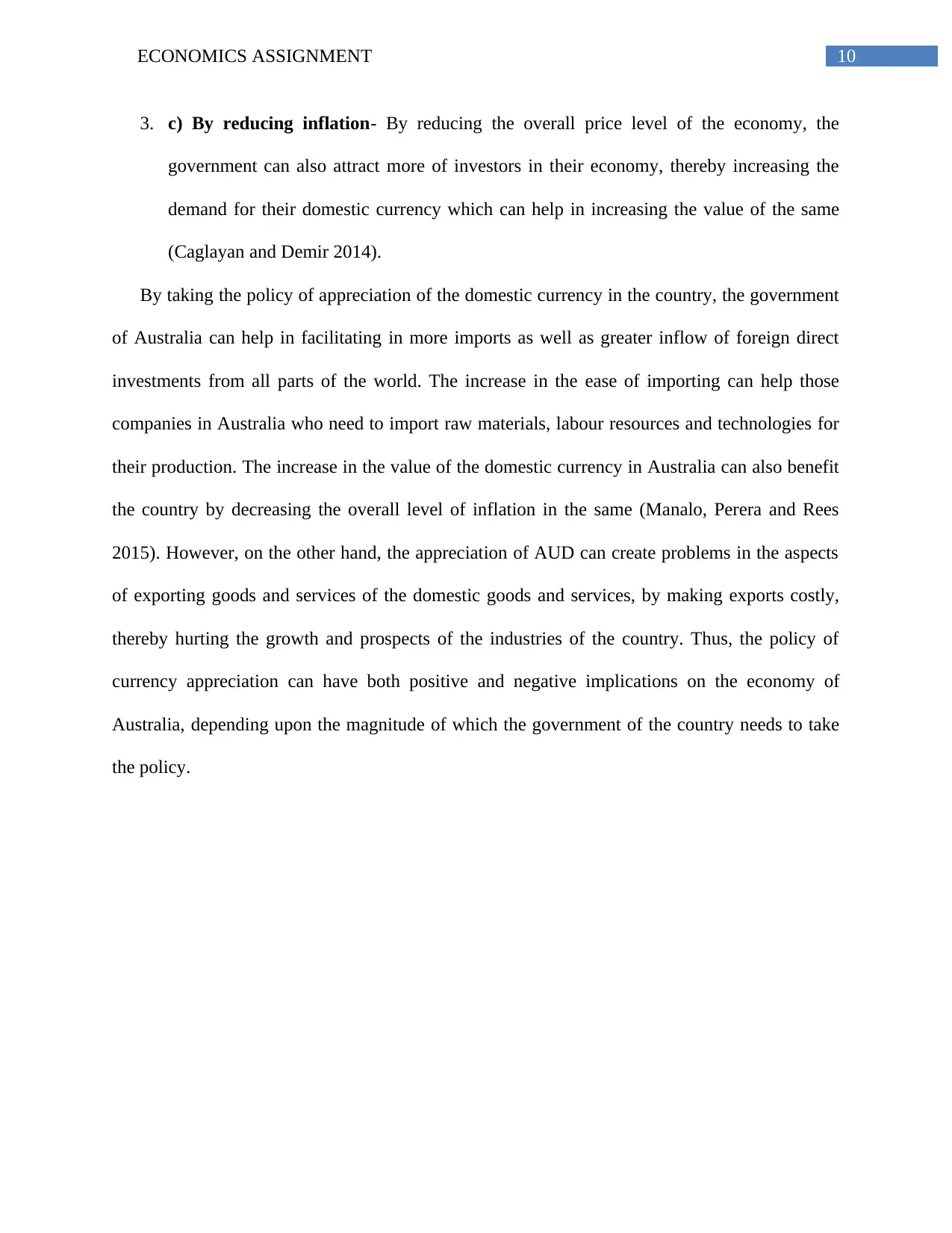
10ECONOMICS ASSIGNMENT
3. c) By reducing inflation- By reducing the overall price level of the economy, the
government can also attract more of investors in their economy, thereby increasing the
demand for their domestic currency which can help in increasing the value of the same
(Caglayan and Demir 2014).
By taking the policy of appreciation of the domestic currency in the country, the government
of Australia can help in facilitating in more imports as well as greater inflow of foreign direct
investments from all parts of the world. The increase in the ease of importing can help those
companies in Australia who need to import raw materials, labour resources and technologies for
their production. The increase in the value of the domestic currency in Australia can also benefit
the country by decreasing the overall level of inflation in the same (Manalo, Perera and Rees
2015). However, on the other hand, the appreciation of AUD can create problems in the aspects
of exporting goods and services of the domestic goods and services, by making exports costly,
thereby hurting the growth and prospects of the industries of the country. Thus, the policy of
currency appreciation can have both positive and negative implications on the economy of
Australia, depending upon the magnitude of which the government of the country needs to take
the policy.
3. c) By reducing inflation- By reducing the overall price level of the economy, the
government can also attract more of investors in their economy, thereby increasing the
demand for their domestic currency which can help in increasing the value of the same
(Caglayan and Demir 2014).
By taking the policy of appreciation of the domestic currency in the country, the government
of Australia can help in facilitating in more imports as well as greater inflow of foreign direct
investments from all parts of the world. The increase in the ease of importing can help those
companies in Australia who need to import raw materials, labour resources and technologies for
their production. The increase in the value of the domestic currency in Australia can also benefit
the country by decreasing the overall level of inflation in the same (Manalo, Perera and Rees
2015). However, on the other hand, the appreciation of AUD can create problems in the aspects
of exporting goods and services of the domestic goods and services, by making exports costly,
thereby hurting the growth and prospects of the industries of the country. Thus, the policy of
currency appreciation can have both positive and negative implications on the economy of
Australia, depending upon the magnitude of which the government of the country needs to take
the policy.
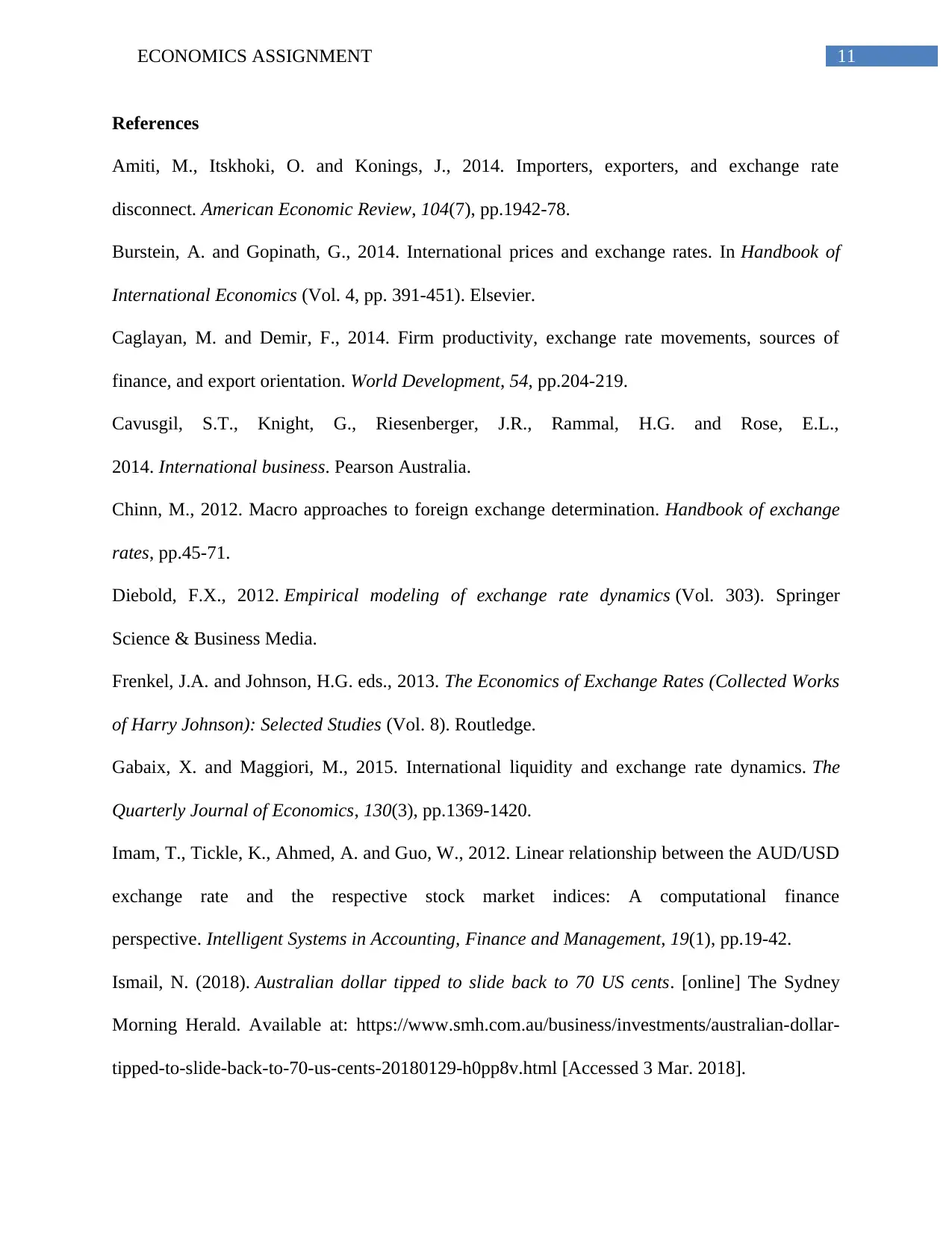
11ECONOMICS ASSIGNMENT
References
Amiti, M., Itskhoki, O. and Konings, J., 2014. Importers, exporters, and exchange rate
disconnect. American Economic Review, 104(7), pp.1942-78.
Burstein, A. and Gopinath, G., 2014. International prices and exchange rates. In Handbook of
International Economics (Vol. 4, pp. 391-451). Elsevier.
Caglayan, M. and Demir, F., 2014. Firm productivity, exchange rate movements, sources of
finance, and export orientation. World Development, 54, pp.204-219.
Cavusgil, S.T., Knight, G., Riesenberger, J.R., Rammal, H.G. and Rose, E.L.,
2014. International business. Pearson Australia.
Chinn, M., 2012. Macro approaches to foreign exchange determination. Handbook of exchange
rates, pp.45-71.
Diebold, F.X., 2012. Empirical modeling of exchange rate dynamics (Vol. 303). Springer
Science & Business Media.
Frenkel, J.A. and Johnson, H.G. eds., 2013. The Economics of Exchange Rates (Collected Works
of Harry Johnson): Selected Studies (Vol. 8). Routledge.
Gabaix, X. and Maggiori, M., 2015. International liquidity and exchange rate dynamics. The
Quarterly Journal of Economics, 130(3), pp.1369-1420.
Imam, T., Tickle, K., Ahmed, A. and Guo, W., 2012. Linear relationship between the AUD/USD
exchange rate and the respective stock market indices: A computational finance
perspective. Intelligent Systems in Accounting, Finance and Management, 19(1), pp.19-42.
Ismail, N. (2018). Australian dollar tipped to slide back to 70 US cents. [online] The Sydney
Morning Herald. Available at: https://www.smh.com.au/business/investments/australian-dollar-
tipped-to-slide-back-to-70-us-cents-20180129-h0pp8v.html [Accessed 3 Mar. 2018].
References
Amiti, M., Itskhoki, O. and Konings, J., 2014. Importers, exporters, and exchange rate
disconnect. American Economic Review, 104(7), pp.1942-78.
Burstein, A. and Gopinath, G., 2014. International prices and exchange rates. In Handbook of
International Economics (Vol. 4, pp. 391-451). Elsevier.
Caglayan, M. and Demir, F., 2014. Firm productivity, exchange rate movements, sources of
finance, and export orientation. World Development, 54, pp.204-219.
Cavusgil, S.T., Knight, G., Riesenberger, J.R., Rammal, H.G. and Rose, E.L.,
2014. International business. Pearson Australia.
Chinn, M., 2012. Macro approaches to foreign exchange determination. Handbook of exchange
rates, pp.45-71.
Diebold, F.X., 2012. Empirical modeling of exchange rate dynamics (Vol. 303). Springer
Science & Business Media.
Frenkel, J.A. and Johnson, H.G. eds., 2013. The Economics of Exchange Rates (Collected Works
of Harry Johnson): Selected Studies (Vol. 8). Routledge.
Gabaix, X. and Maggiori, M., 2015. International liquidity and exchange rate dynamics. The
Quarterly Journal of Economics, 130(3), pp.1369-1420.
Imam, T., Tickle, K., Ahmed, A. and Guo, W., 2012. Linear relationship between the AUD/USD
exchange rate and the respective stock market indices: A computational finance
perspective. Intelligent Systems in Accounting, Finance and Management, 19(1), pp.19-42.
Ismail, N. (2018). Australian dollar tipped to slide back to 70 US cents. [online] The Sydney
Morning Herald. Available at: https://www.smh.com.au/business/investments/australian-dollar-
tipped-to-slide-back-to-70-us-cents-20180129-h0pp8v.html [Accessed 3 Mar. 2018].
⊘ This is a preview!⊘
Do you want full access?
Subscribe today to unlock all pages.

Trusted by 1+ million students worldwide
1 out of 13
Related Documents
Your All-in-One AI-Powered Toolkit for Academic Success.
+13062052269
info@desklib.com
Available 24*7 on WhatsApp / Email
![[object Object]](/_next/static/media/star-bottom.7253800d.svg)
Unlock your academic potential
Copyright © 2020–2025 A2Z Services. All Rights Reserved. Developed and managed by ZUCOL.





